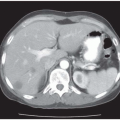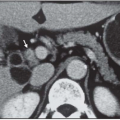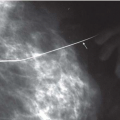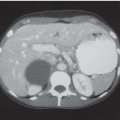Case 81
Presentation
A 53-year-old woman with a past medical history of hypertension and depression undergoes a routine serum chemistry check and is found to have an elevated serum calcium level of 13.5 mg/dL (3.4 mmol/L), a mildly elevated serum alkaline phosphatase, and a low serum phosphorus level of 1.8 mg/dL (0.58 mmol/L). She complains of general fatigue and polyuria. On physical examination she has normal vital signs; head and neck examinations reveal no adenopathy, and a palpable 2-cm nodule is found in the right thyroid lobe. Heart and lung examinations are within normal limits.
Differential Diagnosis
The differential diagnosis of elevated serum calcium in a patient with normal renal function includes primary hyperparathyroidism, paraneoplastic syndrome, metastatic carcinoma with lytic bone metastases, granulomatous diseases, familial hypocalciuric hypercalcemia, and parathyroid carcinoma. In patients with renal failure, secondary or tertiary hyperparathyroidism must be considered. In this patient, given her age, mild symptoms, and the lack of history of renal failure, the most likely diagnosis is primary hyperparathyroidism. The relatively high presenting serum calcium level and the palpable neck mass raise the suspicion for parathyroid carcinoma.
Discussion
Primary hyperparathyroidism is the third most common endocrine disorder in postmenopausal women. Over 80% of the patients have solitary benign adenomas, while approximately 15% of cases harbor multigland hyperplasia. The usual presentation of this disease is mild to moderate hypercalcemia, with an elevated serum parathyroid hormone level and no significant physical findings on neck examination. The markedly elevated serum calcium and a palpable mass on neck examination raise the suspicion of parathyroid carcinoma. However, most patients who present with primary hyperparathyroidism and a palpable neck mass have both a routine parathyroid adenoma and a thyroid nodule.
The diagnosis of primary hyperparathyroidism necessitates the findings of elevated serum calcium, elevated or inappropriate intact serum parathyroid hormone (PTH) level, and normal serum creatinine level.
Preoperative localization studies can allow more directed surgical treatment. A technetium-99mmethoxy isobutyl isonitrile (Sestamibi) scan with single-photon emission computed tomography (SPECT) can identify the enlarged hyperfunctional gland in up to 80% of cases. Adding SPECT allows three-dimensional evaluation of the gland location in relation to other structures in the neck, such as the thyroid and esophagus. If a SPECT scan cannot be obtained, a dedicated parathyroid neck ultrasound can provide the anatomic detail to complement the Sestamibi scan.
Recommendation
Additional serum tests for intact PTH and creatinine levels as well as a Sestamibi scan with SPECT. Also, a high water intake and elimination of calcium from the diet is advised.
Case Continued
Serum intact PTH and creatinine levels are obtained. She has normal renal function, but the PTH level is elevated (370 pg/mL, normal range 10 to 60).









